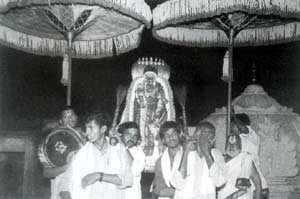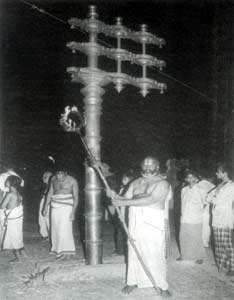

| Report – Melukote |
Procession on the Temple Terrace
Melukote is a temple town in the Mandya district of Karnataka. A centre of Srivaishnavism (established by the saint Sri Ramanjuacharya in 12th century A.D.) the small town comes alive during rituals (poojavidhi), special festivals (ussavas) and speical celebrations. The peaceful township takes us back to the 12th century A.D. through the temple rituals and traditions. Sri Ramanujacharya has laid down the ritualistic tradition and the devotees and followers of Srivaishnava faith participate in all these festival and rituals.
The principal deity of Melukote in Vishnu in the form of Cheluvanarayanaswamy. ‘Cheluva’ means charismatic. The antiquity of the place is attributed to Yadavagiri and Dakshina Badarikashrama of ancient times that gained historical importance due to the patronage of the Hoysala King Vishnuvardhana. Sri Ramanujacharya had to leave Sriangam to avoid the persecution and entered the Hoysala territory following the course of the river Cauvery. Ramanathapura is the entry point of Sri Ramanuja in Karnataka, and he stayed for a while at Saligraama. Later he proceeded to Tondanur on the assurance of the Hoysala King. Hoysala Bittrideva a Jaina King was greatly impressed by the devotional fervor and philosophy and Ramanuja and became the disciple of Ramanuja and changed his name to Vishnuvardhana. The legend has it that Ramanuja (in a dream) discovered the idol of Tirunarayana in an anthill surrounded by thick vegetation and small streams. Situated in a small extended valley with a raised hillock Melukote even today is appealing with its natural habitat untouched by urban vagaries.
Festivals like Angamanu utsava, Vairamudi, Krishnarajamudi, Tirunakshtra of Sri Ramunajacharya and Kalyanotsava are some of the major celebrations, whereas Kothaarotsava, Punarvasu, Aridra Nakshatra and many other rituals are offered daily, and are confined mainly to the families associated with the temple service and the inhabitants of the township.
Melukote, after the Vairamudi* festival passes into a quite atmosphere when God himself perhaps wishes to enjoy His solitude. Even the followers of Srivaishnavism choose to experience the divine presence of their Lord all by Himself without His consorts, Sri Lakshmi and Bhudevi. The arachakas get busy in the preparation of a unique ritual known as Veylmalige utsava.
On the last days of Chitrabhanu Samvatsara phalguna Amavasya, uttarabhadra nakshatra as per the Hindu Almanac (1st April 2003) the Veylmalige utsava is held at the shrine of Sri Cheluvanarayanaswamy.
Sri Ramanujacharya visualized Lord Cheluvapille in the form of para-Vasudeva and had prescribed the process of the festival of Veylmalige. Among the several forms of Mahavishnu, para – Vasudeva, is represented in the Pancharatra ideology. The transcendental from of Mahavishnu is associated with the parama pada, the divine abode, Vaikuntha where the Lord is resting on the coils of Adisesha, the great serpent.
This Vaikunta Narayana from is all pervasive and primordial to the vision of the devotees specially assembled to take the divya darshan at Melukote. According to Vihagendra Samhita He is in this aspect visualized as pure and resplendent (mahaparama bhavasvaram) like a clear crystal. he is two armed and is clothed in garments, golden yellow in colour. He is complete and pervasive, free from all tendencies, positive or negative. He is even free from his consorts. The Ahirbudhnya samhita narrates the concepts of para as the transcendental aspect of Vasudeva and is always conjoined with Lakshmi. Texts likeParameshvara samhita, however mention Bhu also as associated with para – Vasudeva.
Sri Cheluvanarayanaswamy on the day of Veylmalige utsava is adorned with divine ornaments. The temple prakara is closed to the public. Neither the usual mangalavadya, the auspicious music nor the divine chanting as always observed in other festivals are performed. Even the Garuda is not sent around the temple precinct before the arrival of the main deity, as is the usual practice. Idol is covered with a long silk cloth and carried by four inmates of the temple, without any kind of suggestion of a procession. The image is carried to the south-west corner of the temple precinct, where a flight of large size steps lead to the terrace of the temple. This particular door to terrace is normally closed. it is only opened once to the public during Veylmalige festival. Through this passage God is taken with devotion to the terrace.
The Vaikunatha Narayana is in the commune of very few, the highest-ranking priests and Shrivaishnava devotees. After a while the ringing of the bell is heard and arati offered which marks the divine permission for those who are around and waiting in the pillared hall below the steps to got and partake in the Veylmalige festival. The local people are the main participants and they consider themselves as the blessed few by the Vaikuntha Narayana.
The idol of the Lord is unveiled and raised to a height so that the people around can have the divine darshana. The oil-lamps are particularly designed in the crescent form, which give more light when the young members carry these lamps on the two sides of the path paved by the devotees. Facing the processional images the senior member of the temple Sthanikas begins chanting. As the first steps of the ritual, thearghya is offered though the ritual-utensil known as Karaga. The sacred food, neivedya is offered to the God, in accordance with the season and climate. It is salad, made of moong dal, cucumber and limejuice. After the Lord partakes it , it is distributed among the people around. Hierarchy is maintained while offering the prasada. The chantings are like the repository of the traditions and transmitted by memory even among young boys. They join their elders in the chants. The chanting narratives in Sanskrit, Tamil or the local language Kannada vibrating through the atmosphere renew the living presence of the Lord in all His unique manifestations. The torches brighten the visual image of the Lord persona, which enliven the hearts of the devotees. the white umbrellas signifying the royal insignia are raised to great heights, piercing though the darkness as they move in slow movements and take us to different world.
It is the Amavasya night, and the rituals falls on the day when Ravana was vanquished and killed. The three worlds rejoice the event and to symbolize that good prevails over evil the festival is performed. the event may be a myth but reality is in the belief that continues to integrate the people of all regions in all strata of society irrespective of any sectarian difference. The sources of the chanting are directly taken from the text like Sangita Ramayana. Another interesting chant one can observe is that God is eulogized in a similar way the king of the region is eulogized. The procession moves on the terrace from one end to the other five times amidst chanting and singing. It is believed that this stroll amidst his choicest disciples relieves Him from stress resulting from continuous festivities.
The second part of the procession is enacted in the pillared hall, which runs as the wide corridor around the main shrine of the temple precinct. The Lord descends from the terrace only when all His disciples go before him. They come down and take positions in the corridors to have a glimpse of the Lord and anxiously wait to see His pranks that He begins to throw.
Saint Ramanuja visualized this festival in a special manner. He wanted to experience the childhood of this beloved a Lord and Lo! it is amazing and a life-time experience to see how the atmosphere evokes. The Lord descends from the steps like a child; running down, stopping abruptly, demanding something beyond the reach of mortals. To appease Him, special food offering is made, a mirror is shown, the Araiyar sings and runs in a brisk manner. Yet, with all this He is not pleased, He is angry, going in an unrhythmic pace. Oh yes! The singing slows the pace. He is pleased and sways in a beautiful swinging movement. He stops again. He is observing whether His living presence is felt. To ensure, He runs and runs like child Krishna through the corridor. Again He is offered special food and betel-leaf in an artistically designed silver container. A spittoon is shown, in which the Lord spits. All hope He cooled down. Oh no. He is again walking the throwing tantrums like a child. In the same mood God exits from the scene, and suddenly enters His shrine.
|




